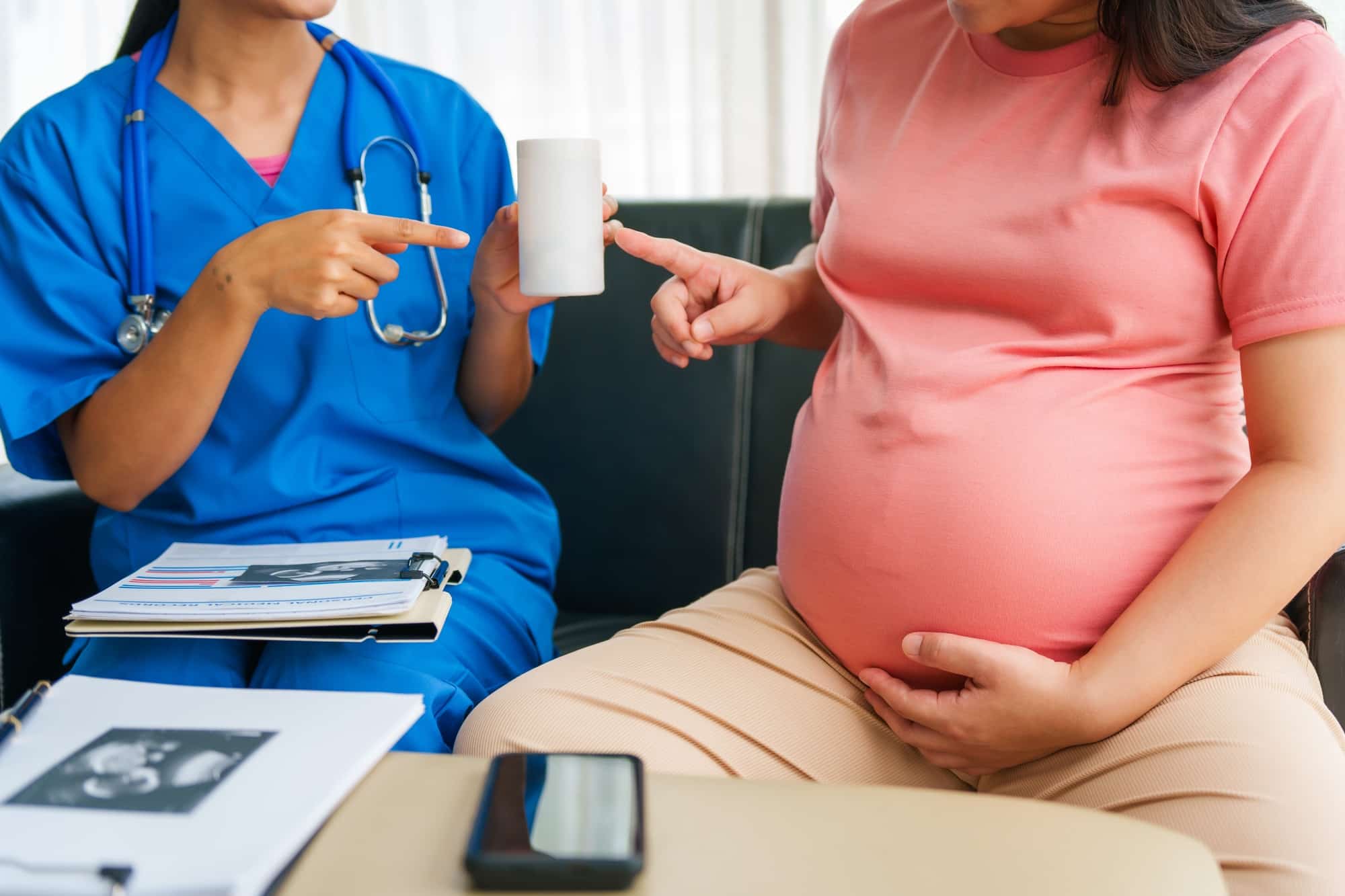Postpartum preeclampsia (PE) is a rare disease that can happen to a woman after childbirth putting her at risk for a seizure and can be deadly. It starts with “new onset,” of high blood pressure that may happen shortly after delivering a baby and needs to be treated quickly before it gets more serious.
What is Postpartum preeclampsia?
Preeclampsia (PE) is a high blood pressure condition of pregnancy usually “new onset,” due to a combination of maternal (mother) and fetal risk factors that can damage blood vessels and may lead to kidney, liver, and brain injury in severe cases. It can be “mild,” or when severe called eclampsia (sudden onset of seizures) and can happen during the latter part of pregnancy or after childbirth. Protein may spill into the urine but not in all cases. This happens because the lining of the small blood vessels called glomeruli or filters of the kidney are injured and leaks protein into the urine.
The most well-known PE happens after 20 weeks of pregnancy during the second and third trimester and is cured by delivering the baby. The least well known is postpartum preeclampsia that happens after childbirth in what has been called the “fourth trimester,” of pregnancy.
Postpartum preeclampsia occurs in as many as 1 in 4 cases of PE, usually within 48 hours after birth but sometimes up to 6 weeks later. In a case series, 55 % of women diagnosed with postpartum preeclampsia had not been diagnosed earlier in their pregnancy and one-third had full-blown eclampsia in the postpartum period.
In fact, cardiovascular disease including high blood pressure is the leading cause of death among new mothers and accounts for more than 1 in 3 pregnancy related deaths in the United States.
High blood pressure represents a spectrum of diseases in pregnancy, beginning with the most mild or gestational hypertension or high blood pressure of pregnancy, preeclampsia and if untreated can progress to severe features of eclampsia (which may occur without preeclampsia) that causes vascular injury of the brain leading to seizures, brain swelling and other organ damage.
What are the symptoms of Postpartum Preeclampsia?
High blood pressure after delivery or postpartum is most commonly due to having high blood pressure before pregnancy. If it’s new onset or getting worse within 48 hours to 6-weeks of delivery especially if blood pressure is 160/110 or greater or 140/90 with another symptom, then it could be postpartum preeclampsia and must be treated immediately. It’s considered a medical emergency as even “mild,” cases may progress rapidly.
Testing usually reveals an abnormal amount of protein in the urine that can be easily detected on urine dipstick but does not need urine protein to make the diagnosis and in fact cases can be missed if providers are relying on positive urine testing for the diagnosis.
The most common symptom of preeclampsia (PE) is a severe headache due to the rise in blood pressure and may have other neurologically symptoms like visual changes with sensitivity to light, blurred vision or flashing lights that can help distinguish it from a simple postpartum headache that is much more common.
Other symptoms may include shortness of breath, nausea or vomiting, abdominal pain, edema or swelling, decrease in urination, protein in the urine and if large amounts may look “bubbly,” or foamy, and if symptoms are severe can lead to kidney and liver damage, heart failure, low platelets (cells responsible for clotting) and HELLP syndrome. It’s estimated that 30-50% of women who progress to eclampsia can also have HELLP syndrome.
HELLP syndrome stands for Hemolysis or breakdown of red blood cells, EL with elevation in liver enzymes indicating liver damage, and LP or low platelets that effects blood clotting and can be life threatening. It can in severe cases damage the kidneys, make the lungs fill with fluid, brain to swell and if untreated can be fatal.
How is Postpartum Preeclampsia treated?
The key to treatment in postpartum PE is lowering of blood pressure with medications and depending on the severity of high blood pressure and if involving other organ systems will require hospitalization to treat rapidly with intravenous (IV) blood pressure medications, seizure medications, diuretics or water pills if needed, and once stabilized to transition to oral medications.
This differs from PE during pregnancy found in the second and third trimesters that usually improves with delivery of the baby whereas in postpartum PE the baby is already delivered but due to a cascade of events that is not completed understood is treated effectively with medications if diagnosed early enough.
High blood pressure especially in the postpartum period with fluid shifts can result in high pressures to the brain that can increase wall tension on the blood vessels placing women at higher risk for brain swelling and a brain bleed so critical to rapidly get blood pressure under control especially at higher levels.
What are the risk factors for Postpartum Preeclampsia?
Postpartum preeclampsia is on the rise and in fact is the number one reason for women in the postpartum period for readmission to a hospital. It’s an important disease to promptly recognize as can lead to death and significant morbidity or illness if not identified and treated quickly.
The risk factors for postpartum preeclampsia (PE) includes advanced maternal age above 35 years, obesity, black race, history of high blood pressure with a previous pregnancy and having a caesarean (C-section) delivery with 2 to 7-fold higher risk over a vaginal delivery. The cause of these vascular disorders isn’t fully understood but researchers are working hard to understand. Preeclampsia was once coined as “toxemia,” of pregnancy due to a blood toxin which we now know is not the case.
Preeclampsia is also caused by changes in the placenta but is not completely understood. Placenta is a temporary connection that forms in a woman’s uterus during pregnancy that allows nutrients and oxygen to be delivered to the baby through the umbilical cord. In PE, placental growth alterations may lead to reduction in blood flow and tightening of the arteries contributing to the rise in blood pressure with high levels of placental derived growth factors (PIGF) amongst others identified in blood samples of women with both preeclampsia of pregnancy and postpartum preeclampsia.
Why this happens is unclear but could be due to genetic, environmental factors, the mother’s immune system, and pre-existing medical problems. Also, blood specimens in some studies have shown an elevation of immune cells in women which may also contribute to this condition.
What are the outcomes for Postpartum Preeclampsia?
Studies suggest that risk of severe outcomes for women may be worse for postpartum preeclampsia than preeclampsia during pregnancy as may have a higher risk of stroke and going into full-blown eclampsia including seizures. This could be due in part to closer monitoring during pregnancy by doctors to detect the rise in blood pressure earlier and treat sooner but also potential lack of awareness by providers at urgent care, and emergency rooms to consider preeclampsia in the postpartum period, and that it does not require the presence of protein in the urine to make the diagnosis.
More than 60 % of maternal deaths happen in the post-partum period of which hypertension or high blood pressure was a contributing factor. A recent article out of Journal of American Medical Association (JAMA) showed a 28 % rise in pregnancy related death during 2018 to 2022 at the height of the COVID pandemic with cardiovascular disease and hypertension or high blood pressure as a leading cause with one-third of all deaths happening after delivery of the baby.
The American College of Obstetrics and Gynecology now recommends that all women see a doctor within the first three weeks of having a baby with follow up and on-going care as needed.
The long-term outcomes in women with high blood pressure during pregnancy says the American Heart Association places her at higher risk for getting later in life cardiovascular disease, long term high blood pressure, and heart failure and in a study showed that many women with postpartum preeclampsia continued to require blood pressure medications longer term.
Any last thoughts on Postpartum Preeclampsia?
Preeclampsia and eclampsia are high blood pressure conditions and may affect up to 10 % of women worldwide and may be higher. Postpartum preeclampsia (PE) is a rare and likely underreported condition found in the fourth trimester or after a baby is delivered and is a diagnosis that can easily be missed due to lack of follow up care, lower awareness in the medical community, and failure for the new mom to recognize early warning signs with the most common being a headache as a symptom of blood pressure rising.
Recently, Meghan Markle revealed that she battled with postpartum preeclampsia and how scary it was especially after a having a baby and during a time where moms are enjoying the pleasures of motherhood. Other celebrities had similar experiences including Beyonce and Kim Kardashian just to list a few.
Why some women get high blood pressure of pregnancy, preeclampsia, or full-blown eclampsia and its timing-second, third or fourth trimester is unclear but important in all stages of pregnancy and after delivery to see your doctor on a regular basis. And, if not feeling well especially if getting headaches check your blood pressure and if high to seek medical attention immediately.
If you have any questions AskDoctorH we are here to help.




 Have Questions? AskDoctorH
Have Questions? AskDoctorH